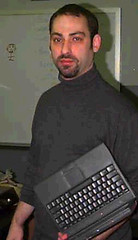I wrote yesterday (North Carolina Aims for the 21st Century) about my state’s Future-Ready Students for the 21st Century goals, commenting on some aspects of the learning and teaching elements. As the day progressed, I found myself thinking more about the process. As a thirty-year educator, I have seen many such initiatives in North Carolina, most of which I can’t even remember the names of, even though they were, in their times, household terms.
One thing that they all had in common was that they were top-driven. In most cases they came from the legislature, through the State Department of Public Instruction (DPI), into our regional service centers (before the legislature ended them), into district central offices, and then to the classrooms — where resources were provided and state professional development was delivered.
It was really the only way..
Until now!
 The entire information landscape has dramatically changed in the last few years, an idea that many of the Future-Ready Students‘ goals certainly reflect. However, is there an opportunity here to make the entire state education system future-ready. Rather than handing the plan down to the future, we might, in today’s new information environment, dance together into the future. Rather than reshaping schools as a sermon, reshape them as a conversation, among communities and professional educators at all levels.
The entire information landscape has dramatically changed in the last few years, an idea that many of the Future-Ready Students‘ goals certainly reflect. However, is there an opportunity here to make the entire state education system future-ready. Rather than handing the plan down to the future, we might, in today’s new information environment, dance together into the future. Rather than reshaping schools as a sermon, reshape them as a conversation, among communities and professional educators at all levels.
Here’s how it might take shape:
- Open it up by making read/write web applications available to educators and communities with professional development. I know of two distance learning programs at DPI that could probably put together very effective learning modules for blogging, wikis, etc. fairly quickly and easily. Put it out there and open it up.
- Work at the district level to acquaint leadership with the tools of broad conversation and ask them to identify key school, classroom, and community leaders and extend direct invitations to them to engage in this conversation.
- Establish an online document of issues and essential questions related to making classrooms, schools, and communities future-oriented to make students future-ready. Some issues and questions already exist in this document from the state DPI web site. Among them…
- What will the future-ready school look like?
- How do we assess future-ready skills?
- What do future-ready professional educators look like and how do we achieve that?
- What conditions support 21st century teaching and learning?
- Do we have the necessary support systems?
- What are the potential implications?
- Each issue, question, and vision area would have its own meta tag. This document could easily be turned into a content aggregator where all of the teacher, administrator, and community statements (blogs, podcasts, and wiki pages) would automatically be referenced within the document creating a growing, dynamic, living resource, an ever adapting plan for schools that continue to prepare children for THEIR future.
2¢ Worth!
Runs with Scissors, “1997.” Runs With Scissors’ Photostream. 20 June 2006. 29 Dec 2006 <http://flickr.com/photos/kenstein/171621683/>.

Dave,
I completely agree with you. I am fortunate to be a principal in a school district that “gets it” when it come to the importance of the 21st Century Skills and the Read/Write web (Deerfield School District 109 in Deerfield, Illinois.) Last year, we brought in Alan November to get us started, and then we created a committee of parents, teachers, and administrators that developed a three year plan to incorporate the 21st Century Skills into our curriculum. We are now in year one, and we are quite excited about this. We are working with Ed Coughlin of the Metiri Group this year. I think we are one of a handful of districts in Illinois (maybe the only one?) pushing this very important agenda amidst a culture of NCLB high-stakes testing. I have been writing about this in my own blog the last few days, and I am hoping others will take notice of our work. http://blog109.org/communities/dsherman/default.aspx
Have a Happy New Year!
Dave Sherman